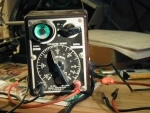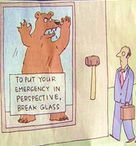1041 wrote:I have "spontaneous arousal syndrome" or, something messing up my sleep that is not simple OSA.
People have suggested the following causes and solutions:
-UARS: BiPAP
-GERD: raise bed, change diet
-nasal congestion: medication, surgery
-chronic pain: medication
-side effects of medications: stop taking them
-RLS/PLMD: medication
But I've only found one thread where someone actually comes back and says, Yes, this was the cause and treating it enabled me to sleep deeply again. (loonlvr)
Does anyone know of other success stories?
Hi 1041,
I believe I have dealt with and am dealing with all that you have mentioned except perhaps chronic pain. I think that all of these including chronic pain stem from messed up chemoreflexes which are being knocked off center by stress.
The largest positive changes for me recently came after I moved from a big city where I felt threatened by many there who hate my race (I am white) and love my vulnerability (I am “mature” and poor). It also has more sun time and a built in exercise program for me with many hills (I no longer drive). I saw reductions using the other things I will share here but the reduction in stress by moving away from threat made very notable positive changes in the first few weeks which have continued to improve as the months have progressed.
I believe your biggest obstacle to improvement of these symptoms is the stress in your life.
I think I should also mention that I do not believe in using CPAP or any kind of PAP “flying blind”. Yes, one might think that in North Dakota one might get on that strangely strait road, lock arms and foot pressure, close eyes and drive for miles. One might also end up dead trying that trick, indeed. So when you use CPAP you need to set up and use feedback, you need to have your eyes open to what is actually going on at night. You need to download good software for your machine and do the work to understand what the resultant charts mean. Or, if you have means, you need to contact a company which will daily download and analyze your data for you. I recommend the first as the daily feedback will likely result in corrective lifestyle changes along the way which can be very much life preserving.
So lets look at what you have specifically mentioned:
1041 wrote:-UARS: BiPAP
Upper Airway Resistance Syndrome (UARS). I think of this as air hunger gone mad. If you are breathing at a normal rate of 6 liters of Air per Minute (lpm) at a normal respiratory rate of say 15 breaths per minute (bpm) then a single breath contains about 13.5 oz (400 ml) of air (think a small can of pop). About every four seconds you would move that much air. I try to keep my air use at rest near this level and my simple comment is that it would take a lot of obstruction to make getting this much air difficult.
If you had been working out very hard the amount of air you use may go up as high as 150 lpm. If they breath about 80 bpm each breath will contain about a half gallon of air. Few probably get up to this rate but I think anyone who did would have their mouth open with their head tilted a bit back to make room for the air to move. Any obstruction is a problem!
One of the things they discovered in UARS is that the lungs pull so hard against the obstruction that the heart walls warp! That is a lot of breathing hunger! What no one that I have run into so far seems to have examined is how much air they were actually moving and why would their body need that amount of air. My own experience is that I have awakened several times to find myself breathing quite hard. As I take steps to “put the breaks on the breathing” so to speak I note that the air hunger literally dissipates with the air use brought to more normal levels for about forty seconds. My nose also returns from it's congested state to normal and my mouth becomes moist again. Normal breathing is the cure for me.
But many have shown that getting rid of obstruction (think tracheotomy) also seems to cure this. I do a lot of anti-inflammatory food just in case.
1041 wrote:-GERD: raise bed, change diet
First a note about raising the head of one's bed. There is a common thread in OSA research these days showing that OSA tends to bring about a rostral fluid shift (fluids tend to flow toward the nose so the upper tissues inflame) and that the resultant shift tends to cause OSA. I have seen them doing what I think are silly experiments using compression socks during the day to counteract this tend toward shift during the night. I know that raising the head of the bed is less fun than wearing the compression socks and I suppose the special socks that result will be sold for a high price but really – any experiments looking at raising the head of the bed?
I have raised the head of my bed since my physician recommended it for GERD in the early 80's – when real physicians helped real people in real time. The cost has always been under five dollars for me to do this. I have used books (hard on the books, not recommended) wood (too much time) and concrete bricks from a building supply store. Place a bit of cardboard under the bricks and perhaps add a small towel to protect floor or carpet and you are on. Three inches seems to be a good fit for me.
As for diet, half veggies (20% of them raw), balanced for the rest – I tend toward the Harvard Healthy Eating Pyramid for the rest (see:
http://www.hsph.harvard.edu/nutritionso ... t/pyramid/ ). I like to eat a bit of raw veggies before bed (at least a half hour if possible) and often choose Kimchi as I believe it is good for my microbiome.
Never, ever, PPI!
1041 wrote:-nasal congestion: medication, surgery
On my hip I keep a little $50 finger pulse oximeter. I use it to help me find the breathing rate which produces the lowest heart rate as I maintain my exertion level constant. It takes about an hour the first time to find those lowest heart rates – say while at your desk or while doing moderate exercise on a tread mill. Once you do that the SpO2 reading becomes a good guide to quickly find that breathing rate.
One of the things that becomes obvious as you do this kind of training is that certain things are a clue that you are breathing to much air. The one that most often serves me is that my nose stuffs up. So now when I notice this I first stop breathing for a few seconds, and then continue breathing at a lower rate and volume. This really does work to keep my nose clear without drugs.
This is consistent when I use CPAP as well. I have spent many hours training with CPAP and if I do wake up with a dry stuffy nose breathing less always clears it.
The first thing I do when I put on my CPAP is work to tone down the breathing rates. I have often used the pulse oximeter as a guide while I do this and will again if I note any breathing instability issues in my data.
I have been doing the training I mention above for ten months now. I consider this training of my breathing reflexes something like learning to play a musical instrument – a thing that will require nearly daily practice and will take years to learn. I do note lower minute volumes in my CPAP data even in this short time, I was able to smell the flowers this summer instead of running to the pharmacy for allergy drugs, and I am even loosing weight. I think it is worth the time and effort.
1041 wrote:-chronic pain: medication
I do believe that less tendency toward hyperventilation means better good blood flow to the brain and brain cells throughout the body. If those cells all work as they should together I believe their will be less chronic pain.
1041 wrote:-side effects of medications: stop taking them
“stop taking them” - When I am put onto a medication I start making a plan to get off of that medication. If I do not do that the crazy western medicine pill machine will eat my money, make me sick, and kill me. “stop taking them” - indeed!
1041 wrote:-RLS/PLMD: medication
This seems most variable in me due to stress. I also think that good circulation will help as well.
FWIW
Todzo














